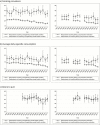Diverging trends in smoking behaviors according to mental health status
- PMID: 25180078
- PMCID: PMC5479511
- DOI: 10.1093/ntr/ntu173
Diverging trends in smoking behaviors according to mental health status
Abstract
Introduction: People with mental health disorders are much more likely to smoke compared to those who do not. This study investigates recent trends in smoking behaviors among both these populations in England.
Methods: We used survey responses from adults (aged 16 years and older) living in households in England who participated in the Health Survey for England from 1993 to 2011 (n = 11,300 per year on average). Linear regression was used to quantify annual changes over the time period in smoking prevalence, daily cigarette consumption, and desire to quit among respondents with and without 2 indicators of mental disorder (self-reported longstanding mental illness and recent use of psychoactive medication).
Results: Among survey respondents who did not report a longstanding mental illness, there were long-term declines in smoking prevalence (-0.48% per year, 95% confidence interval [CI] = -0.56 to -0.40) and daily cigarette consumption (-0.14% per year, 95% CI = -0.17 to -0.11). Similar declines were also seen among respondents not taking psychoactive medications. However, there were no long-term changes in smoking prevalence and cigarette consumption among respondents who reported these indicators of mental disorder, although smoking prevalence among those taking psychoactive medications may have declined during the later part of the study period. Smokers both with and without the 2 indicators of mental disorder showed similar levels of desire to quit smoking.
Conclusions: Smoking is largely unchanged since 1993 among those with indicators of longstanding mental disorders or recent psychoactive medication usage, although declines have been observed among those without such indicators of mental disorder.
© The Author 2014. Published by Oxford University Press on behalf of the Society for Research on Nicotine and Tobacco. All rights reserved. For permissions, please e-mail: journals.permissions@oup.com.
Figures
References
-
- Peto R, Lopez AD, Boreham J, Thun M. Mortality from Smoking in Developed Countries 1950–2005. 2012. http://www.ctsu.ox.ac.uk/~tobacco/ Accessed September 09, 2014.
-
- Coulthard M, Farrell M, Singleton N, Meltzer H. Tobacco, Alcohol and Drug Use and Mental Health. London: The Stationary Office, 2002. http://www.ons.gov.uk/ons/rel/psychiatric-morbidity/tobacco--alcohol-and... Accessed September 09, 2014.
-
- Ziedonis D, Hitsman B, Beckham JC, et al. Tobacco use and cessation in psychiatric disorders: National Institute of Mental Halth report. Nicotine Tob Res. 2008;10:1691–1715. - PubMed
-
- New York State Department of Health. Adults in New York who report poor mental health are twice as likely to smoke cigarettes. Tobacco Control Program StatShot. 5, 2012. http://www.health.ny.gov/prevention/tobacco_control/reports/statshots/vo... Accessed September 09, 2014.
Publication types
MeSH terms
Grants and funding
LinkOut - more resources
Full Text Sources
Other Literature Sources
Medical


